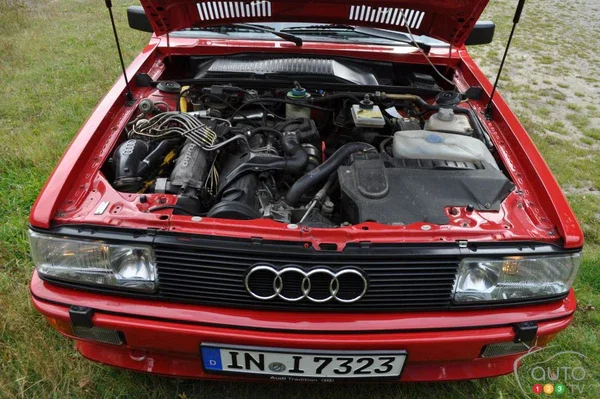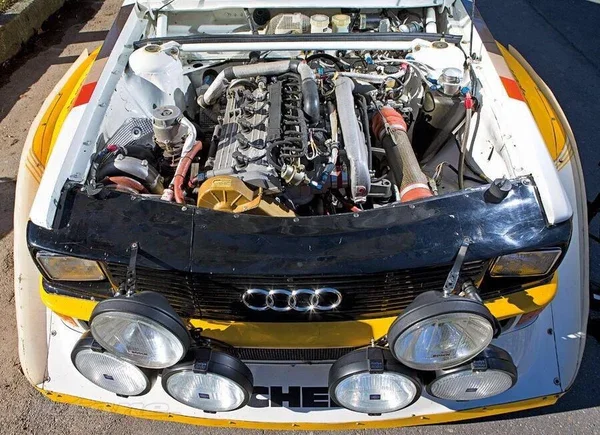Engine-pedia: Audi’s head-kicking turbo 5-cylinder, from UR Quattro to DAZA MADNESS
The five-cylinder is the engine that put Audi on the map in rallying, combining a longitudinal inline-five with permanent AWD. From its legendary rally roots to its modern hot-hatch dominance, the Audi 5-cylinder is an automotive icon, recognised instantly by its unique, aggressive, off-beat firing order (1-2-4-5-3).
Audi’s turbocharged five-cylinder was born out of necessity in the late 1970s. Audi needed a motor more powerful than its existing EA827 four-cylinder but shorter than a six-cylinder for better weight distribution in its new quattro all-wheel-drive system, so they evolved what they had.
The original 1980-1987 5-cylinder was coded WR and was a 2144cc single-cam 10-valve iron block, alloy head monster making 147kW (200hp) with Bosch K-Jetronic mechanical injection and K27 turbocharger. This was dropped for a time to 2133cc to satisfy World Rally Championship rules thanks to a change of bore and stroke to 79.3mm by 86.4mm, before the five-cylinder was eventually increased to 2226cc in 1988 still with a 10-valve SOHC head and producing 147kW (200hp).
These engines used forged steel crankshafts with a 6-main-bearing crank layout, and a lazy 7.0:1 compression, however this was upgraded in the 1989 revision to a much snappier 9.3:1. There were 20-valve (DOHC four-valve-per-cylinder) head variants available with Bosch LH-Jetronic EFI, which produced 225kW (306hp). From the final run of original five-cylinder Audi 80-based models in 1989-1991 the engine scored the DOHC 20-valve cylinder head, which produced 162kW (217hp)
The rallying origins of these iron-block 2.2-litre variants means they have become famous across Europe for holding many times their original power output, and living on redline. Events like Gatebil, where cars are driven like they spend their downtime flicking lit cigarette butts at the owner’s children, see plenty of 500hp+ turbo 5-cylinder Audi engines living on the rev-limiter, smoking four wheels at a time for days at a time.
The second-generation of turbo 5-cylinder engine, coded AAN/ABY/ADU, hit the market in the 90s with a granite-tough right-hook. This generation refined the platform with modern electronics and a collaboration with Porsche that yielded one of the most famous sleepers of all time and created the “fast wagon” craze still enjoyed today.
These engines retained the deep-breathing DOHC 20-valve cylinder head, 2226cc capacity, and donkey-strong cast-iron block with forged-steel crankshaft. A huge upgrade came in the form of Bosch Motronic EFI, while the much larger K24 turbo
Porsche handled the tuning of the RS2, the first high-performance station wagon. Coded ADU it featured 9.0:1 compression and huge refinements in the Motronic EFI allowed Zuffenhausen to squeeze 232kW (315hp) out of the 2.2-litre five cylinder, which is over 140hp-per-litre in factory tune.
After a decade-long hiatus due to the popularity of V6 and V8 engines, the I5 returned as a clean-sheet design in the 2009 TT RS. Audi focused on compact packaging and weight savings, with modern upgrades like the modern direct-injection EFI (TFSI), while it was switched from a longitudinal mounting to transverse to fit the MQB-platform cars it was intended for.
Coded CEPA (TT RS) and CZGA (RS3 8P) the turbo 5-cylinder swelled to 2480cc with a compression ratio of 10:1, and they produced 250kW (340hp). Despite many advancements in technology across the engine Audi retained the iron block of the original engine to handle boost pressure and this allowed enthusiasts to push this platform and reaffirm the Audi I5 as a tuner hero engine.
The current generation (coded DAZA and DNWA) brought the most significant change since the 20V head: a completely new, lightweight aluminum crankcase. This transformation drastically improved the engine's power-to-weight ratio, pushing the 2480cc I5 to a factory-rated 294kW (400hp), but tuners have pushed these cars into 10-second ¼-mile times with only basic bolt-on modifications.
The increased performance of the fourth-generation turbo 5-cylinder has been achieved in part by Audi reducing the engine’s internal friction, pushing higher boost levels, and by adding port-injection alongside the direct-injection of the previous generation I5s. Overall the current-generation I5 is an incredible 26kg lighter than previous generations, with 18kg saved solely from the switch from cast iron to high-quality aluminium for the block.
DAZA engines are currently used in 8V FL/8Y RS3 and 8S TT RS models, while the DNWA-coded engines feature a gasoline particulate filter (GPF). These engines have won International Engine of the Year award an incredible 9-times in-a-row.
The most critical development across the generations is the reduction in mass, particularly in the later Fourth Generation (DAZA/DNWA). The classic engines (from WR to the early 2.5L CEPA) relied on heavy cast iron blocks for rigidity to handle high turbo boost pressures. This placed a substantial weight penalty over the front axle, contributing to the famous "nose-heavy" handling characteristic of early quattro models.
The length of the engine is the main factor determining where the engine can be used. Engines from the UR Quattro (WR) to the RS2 (ADU) were mounted longitudinally to accommodate the original quattro system’s gearbox, which sat behind the engine. This "long" layout meant a significant amount of the engine's mass sat ahead of the front axle line.
Modern 2.5L TFSI engines (CEPA, DAZA) are designed for transverse mounting. This orientation is essential for the compact platforms they power (like the A3/RS3 and TT), which share architecture with other VW Group vehicles. The compact nature of the inline-five cylinder layout (shorter than a V6 or I6) makes it suitable for this tight transverse packaging.
The shift to the lighter, modern aluminum 2.5L TFSI represents Audi's commitment to maintaining the unique 5-cylinder heritage while meeting modern demands for efficiency, low weight, and packaging.





